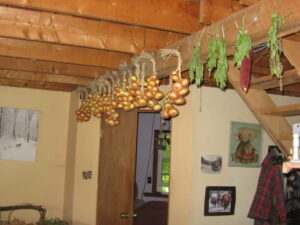- Like
- Digg
- Del
- Tumblr
- VKontakte
- Buffer
- Love This
- Odnoklassniki
- Meneame
- Blogger
- Amazon
- Yahoo Mail
- Gmail
- AOL
- Newsvine
- HackerNews
- Evernote
- MySpace
- Mail.ru
- Viadeo
- Line
- Comments
- Yummly
- SMS
- Viber
- Telegram
- Subscribe
- Skype
- Facebook Messenger
- Kakao
- LiveJournal
- Yammer
- Edgar
- Fintel
- Mix
- Instapaper
- Copy Link
A version of this column first ran in the Roane County (WV) Reporter and Times Record as part of a gardening series. Support local journalism! Subscribe to your local newspaper. This is one of a series of blogs for new gardeners. Start reading the whole series here: Part 1.
Maybe you still have celery in your vegetable bin, and onions in net bags or hanging braids. How to use these lovely paragons of homegrown nutrition?
First I’ll mention a couple of things I’ve recently read about onions. They have antibiotic qualities, like garlic, and can thus help your immune system. And you are not supposed to feed them, or foods containing them to dogs or cats or chickens. My dog begs to differ.
It’s hard for me to talk about ways to cook onions because the subject is so vast—we put onions in practically everything but desserts. I guess I could start by mentioning that it’s easier to peel an onion if you first cut off the root end and the stem end, and then cut it in half. Then you just have to get your thumbnail under the peel, and maybe another layer of onion, and pull it off. Then lay the flat side down, slice it, and if you want chopped onions, chop again at right angles. In frying onions—and onions usually should be fried—you can toss in the chunks and separate the bits with a spatula, which becomes easier as it begins to soften and cook.
One recipe which is fairly new to me is caramelized onions. I thought that was something fancy but it turns out to be ridiculously easy. You just slice the onions, no need to cross chop, and then fry them until they’re done. Then you fry them some more, until they turn brown and shrink quite a lot. They become sweet, and very tasty. I like to do this to use up onions that aren’t going to keep, soon after the harvest. It takes rather a lot of raw onion to make a heap of caramelized onion. I serve this on pasta, usually linguine or fettucine, along with a gob of pesto and some chopped tomatoes. Add some parmesan or other cheese, maybe some herb salt, and that’s an easy, tasty meal.
Not many gardeners try celery, and it is among the more difficult crops, but not by much. You just have to give it rich soil and keep it moist. I’ve never found homegrown celery stalks to be good for eating with cream cheese or peanut butter—they grow those big, succulent stalks in California or Florida in sandy soils, irrigated…and I will now mention why I don’t buy celery if I can’t find the organic label. Years ago a friend who grew up in Florida told of visiting his uncle’s celery and pepper farm, and watching a cat walk through the field the day after they sprayed…and drop dead. Celery and peppers show up on that list of Top Ten Vegetables You Should Buy Organic.
Fortunately celery in one of the things you can often find in organic form, even here.
The first thing to say about how I use celery is that I grow it as much for the leaves as the stalks. I cut them just below the joint so I can hang the leaf from the nails on my kitchen beams. They dry faster than some other herbs, turning a paler green and eventually are dry enough to crumble. I fill a small jar with finely crumbled celery leaf every year. This is nice in soups, and in bread or rolls, especially onion rolls. The flavor complements the onion and the celery leaf balances the wetness of the finely chopped onions when you knead them together into a loaf or a wad of dough destined to become rolls.
Another way I use celery leaves is to just toss a small leaf cluster, from the middle of the plant, into soup, early on, and then fish it out when the soup is done.
As for the stalks, homegrown celery is usually smaller and more fibrous than the commercial stuff. It is slow to cook, so should be chopped small; cut the bigger stalks lengthwise before turning them to chop the other way. Celery is nice with fried potatoes, nice in almost any soup, good in stir fries, and it goes in my Thanksgiving stuffing recipe.
Read the rest: Part 1. Part 2. Part 3. Part 4. Part 5. Part 6. Part 7. Part 8. Part 9. Part 10. Part 11. Part 12. Part 13. Part 14. Part 15. Part 16. Part 17. Part 18. Part 19. Part 20. Part 21. Part 22. Part 23. Part 24. Part 25. Part 26. Part 27. Part 28. Part 29. Part 30. Part 31. Part 32. Part 33. Part 34. Part 35. Part 36.













